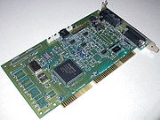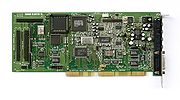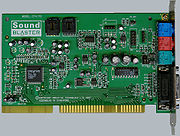
Sound Blaster 16
Encyclopedia
The Sound Blaster
16 is a series of sound card
s by Creative Technology
. They are add-on boards for PCs
with an ISA
or PCI slot.
 Sound Blaster 16 (June 1992), the successor to the Sound Blaster Pro, introduced 16-bit digital audio
Sound Blaster 16 (June 1992), the successor to the Sound Blaster Pro, introduced 16-bit digital audio
sampling to the Sound Blaster
line. The Sound Blaster 16 also added an expansion-header for add-on MIDI-daughterboard
s with sample-based synthesis
capabilities complying to the General MIDI
standard, a socket for an optional digital signal processor
dubbed the Advanced Signal Processor, later Creative Signal Processor (ASP, or later CSP), and an MPU-401
compatible UART for communication with external MIDI-devices.
The Sound Blaster 16 retained the Yamaha OPL-3 chip for FM synthesis, and was mostly compatible with software written for the older Sound Blaster and Sound Blaster Pro sound card
s. The SB16's MPU-401 emulation was limited to UART (dumb) mode only, but this was sufficient for most MIDI software. When a daughterboard, such as the Wave Blaster
, Roland SCD-10
, Roland SCD-15
, Yamaha DB50XG, Yamaha DB60XG was installed on the Sound Blaster, the Wave Blaster behaved like a standard MIDI device, accessible to any MPU-401 compatible MIDI software.
The ASP or CSP chip added some new features to the Sound Blaster line, such as hardware-assisted speech synthesis (through the TextAssist software), QSound audio spatialization
technology for digital (PCM) wave playback, and PCM audio compression and decompression. Software needed to be written to leverage its unique abilities, yet the offered capabilities lacked compelling applications. and so the chip was generally ignored by the market.
The Sound Blaster 16 featured the then widely used TEA2025 operational amplifier which, in the configuration Creative had chosen, would allow approximately 700 milliwatts (0.7 watts) per channel when used with a standard pair of unpowered, 4-Ohm multi-media speakers. By setting an onboard jumper, the user could select between line-level output (bypassing the TEA2025) and amplified-output.
Early Intel PCs built after the IBM PC/AT typically only included support for one ATA interface (which controlled up to two ATA devices.) As computer needs grew it became common for a system to need more than 1 ATA interface. With the development of the CD-ROM
, many computers could not support it since both devices of the one channel were already used. Several Sound Blaster 16 boards provided an additional IDE interface to computers that had no spare ATA-ports for a CDROM, though the additional drive interface typically only supported one device rather than two, it typically only supported CD ROM drives, and it usually could not support additional hard drives.
The Sound Blaster with the SCSI controller (SB 16 SCSI-2) was designed for use with "High End" SCSI based CD-ROM drives. The controller did not have the on-board firmware (Boot BIOS) to start an OS from a SCSI hard drive. Normally that meant that SCSI device ID-0 and ID-1 were not used. As well, if the computer did have a SCSI hard drive with the required SCSI controller then the settings for the SCSI controller on the SB card had to be selected so that the SB SCSI-2 interface did not conflict with the main SCSI controller.
The following model numbers were assigned to the Sound Blaster 16:
Note: various PCB
s with the same model number were shipped with a different configuration regarding CD-ROM interfaces, sockets and presence/absence of the ASP/CSP chip.
operating system
s. It lacked separate bass and treble control, a ASP/CSP socket and Wave Blaster connector.
The following model numbers were assigned to the Sound Blaster VIBRA 16:
Note: various PCB
s with the same model number were shipped with a different configuration regarding CD-ROM interfaces and sockets.
 The Sound Blaster 16 WavEffects was released in 1997 as a cheaper and simpler redesign of the Sound Blaster 16. It came with Creative Technology's WavEffects wavetable software.
The Sound Blaster 16 WavEffects was released in 1997 as a cheaper and simpler redesign of the Sound Blaster 16. It came with Creative Technology's WavEffects wavetable software.
The following model numbers were assigned to the Sound Blaster 16 WavEffects:
and subsequently released the Sound Blaster 16 PCI. The Sound Blaster 16 PCI was based on Ensoniq AudioPCI
technology and is therefore unrelated to the ISA Sound Blaster 16, Sound Blaster 16 VIBRA and Sound Blaster 16 WavEffects.
The following model numbers were assigned to the Sound Blaster 16 PCI:
Sound Blaster
The Sound Blaster family of sound cards was the de facto standard for consumer audio on the IBM PC compatible system platform, until the widespread transition to Microsoft Windows 95, which standardized the programming interface at application level , and the evolution in PC design led to onboard...
16 is a series of sound card
Sound card
A sound card is an internal computer expansion card that facilitates the input and output of audio signals to and from a computer under control of computer programs. The term sound card is also applied to external audio interfaces that use software to generate sound, as opposed to using hardware...
s by Creative Technology
Creative Technology
Creative Technology Ltd. is a Singapore-based global company headquartered in Jurong East, Singapore. The principal activities of the company and its subsidiaries consist of the design, manufacture and distribution of digitized sound and video boards, computers and related multimedia, and personal...
. They are add-on boards for PCs
IBM PC compatible
IBM PC compatible computers are those generally similar to the original IBM PC, XT, and AT. Such computers used to be referred to as PC clones, or IBM clones since they almost exactly duplicated all the significant features of the PC architecture, facilitated by various manufacturers' ability to...
with an ISA
Industry Standard Architecture
Industry Standard Architecture is a computer bus standard for IBM PC compatible computers introduced with the IBM Personal Computer to support its Intel 8088 microprocessor's 8-bit external data bus and extended to 16 bits for the IBM Personal Computer/AT's Intel 80286 processor...
or PCI slot.
Sound Blaster 16

Digital audio
Digital audio is sound reproduction using pulse-code modulation and digital signals. Digital audio systems include analog-to-digital conversion , digital-to-analog conversion , digital storage, processing and transmission components...
sampling to the Sound Blaster
Sound Blaster
The Sound Blaster family of sound cards was the de facto standard for consumer audio on the IBM PC compatible system platform, until the widespread transition to Microsoft Windows 95, which standardized the programming interface at application level , and the evolution in PC design led to onboard...
line. The Sound Blaster 16 also added an expansion-header for add-on MIDI-daughterboard
Daughterboard
A daughterboard, daughtercard or piggyback board is a circuit board meant to be an extension or "daughter" of a motherboard , or occasionally of another card...
s with sample-based synthesis
Sample-based synthesis
Sample-based synthesis is a form of audio synthesis that can be contrasted to either subtractive synthesis or additive synthesis. The principal difference with sample-based synthesis is that the seed waveforms are sampled sounds or instruments instead of fundamental waveforms such as the saw waves...
capabilities complying to the General MIDI
General MIDI
General MIDI or GM is a standardized specification for music synthesizers that respond to MIDI messages. GM was developed by the MIDI Manufacturers Association and the Japan MIDI Standards Committee and first published in 1991...
standard, a socket for an optional digital signal processor
Digital signal processor
A digital signal processor is a specialized microprocessor with an architecture optimized for the fast operational needs of digital signal processing.-Typical characteristics:...
dubbed the Advanced Signal Processor, later Creative Signal Processor (ASP, or later CSP), and an MPU-401
MPU-401
The MPU-401, where MPU stands for MIDI Processing Unit, was an important but now obsolete interface for connecting MIDI-equipped electronic music hardware to Personal Computers...
compatible UART for communication with external MIDI-devices.
The Sound Blaster 16 retained the Yamaha OPL-3 chip for FM synthesis, and was mostly compatible with software written for the older Sound Blaster and Sound Blaster Pro sound card
Sound card
A sound card is an internal computer expansion card that facilitates the input and output of audio signals to and from a computer under control of computer programs. The term sound card is also applied to external audio interfaces that use software to generate sound, as opposed to using hardware...
s. The SB16's MPU-401 emulation was limited to UART (dumb) mode only, but this was sufficient for most MIDI software. When a daughterboard, such as the Wave Blaster
Creative Wave Blaster
The Wave Blaster was an add-on MIDI-synthesizer for Creative Sound Blaster 16, Sound Blaster AWE32, and AWE64 family of PC soundcards. It was a sample-based synthesis General MIDI compliant synthesizer...
, Roland SCD-10
Roland Sound Canvas
Roland/Edirol Sound Canvas lineup is a series of PCM-based MIDI sound modules and PC sound cards primarily intended for computer music usage, created by Roland Corporation. All Sound Canvas modules are General MIDI compatible...
, Roland SCD-15
Roland Sound Canvas
Roland/Edirol Sound Canvas lineup is a series of PCM-based MIDI sound modules and PC sound cards primarily intended for computer music usage, created by Roland Corporation. All Sound Canvas modules are General MIDI compatible...
, Yamaha DB50XG, Yamaha DB60XG was installed on the Sound Blaster, the Wave Blaster behaved like a standard MIDI device, accessible to any MPU-401 compatible MIDI software.
The ASP or CSP chip added some new features to the Sound Blaster line, such as hardware-assisted speech synthesis (through the TextAssist software), QSound audio spatialization
3D audio effect
3D audio effects are a group of sound effects that attempt to widen the stereo image produced by two loudspeakers or stereo headphones, or to create the illusion of sound sources placed anywhere in 3 dimensional space, including behind, above or below the listener.There are several types of 3D...
technology for digital (PCM) wave playback, and PCM audio compression and decompression. Software needed to be written to leverage its unique abilities, yet the offered capabilities lacked compelling applications. and so the chip was generally ignored by the market.
The Sound Blaster 16 featured the then widely used TEA2025 operational amplifier which, in the configuration Creative had chosen, would allow approximately 700 milliwatts (0.7 watts) per channel when used with a standard pair of unpowered, 4-Ohm multi-media speakers. By setting an onboard jumper, the user could select between line-level output (bypassing the TEA2025) and amplified-output.
Early Intel PCs built after the IBM PC/AT typically only included support for one ATA interface (which controlled up to two ATA devices.) As computer needs grew it became common for a system to need more than 1 ATA interface. With the development of the CD-ROM
CD-ROM
A CD-ROM is a pre-pressed compact disc that contains data accessible to, but not writable by, a computer for data storage and music playback. The 1985 “Yellow Book” standard developed by Sony and Philips adapted the format to hold any form of binary data....
, many computers could not support it since both devices of the one channel were already used. Several Sound Blaster 16 boards provided an additional IDE interface to computers that had no spare ATA-ports for a CDROM, though the additional drive interface typically only supported one device rather than two, it typically only supported CD ROM drives, and it usually could not support additional hard drives.
The Sound Blaster with the SCSI controller (SB 16 SCSI-2) was designed for use with "High End" SCSI based CD-ROM drives. The controller did not have the on-board firmware (Boot BIOS) to start an OS from a SCSI hard drive. Normally that meant that SCSI device ID-0 and ID-1 were not used. As well, if the computer did have a SCSI hard drive with the required SCSI controller then the settings for the SCSI controller on the SB card had to be selected so that the SB SCSI-2 interface did not conflict with the main SCSI controller.
The following model numbers were assigned to the Sound Blaster 16:
- CT12**: CT1230, CT1231, CT1239, CT1290, CT1291, CT1299
- CT17**: CT1730, CT1740, CT1749, CT1750, CT1759, CT1770, CT1779, CT1780, CT1789, CT1790, CT1799
- CT22**: CT2230, CT2290
- CT27**: CT2700, CT2740, CT2770
Note: various PCB
Printed circuit board
A printed circuit board, or PCB, is used to mechanically support and electrically connect electronic components using conductive pathways, tracks or signal traces etched from copper sheets laminated onto a non-conductive substrate. It is also referred to as printed wiring board or etched wiring...
s with the same model number were shipped with a different configuration regarding CD-ROM interfaces, sockets and presence/absence of the ASP/CSP chip.
Sound Blaster VIBRA 16
The Sound Blaster VIBRA 16 was released as a cost-reduced Sound Blaster 16 that supported Plug and Play for Microsoft WindowsMicrosoft Windows
Microsoft Windows is a series of operating systems produced by Microsoft.Microsoft introduced an operating environment named Windows on November 20, 1985 as an add-on to MS-DOS in response to the growing interest in graphical user interfaces . Microsoft Windows came to dominate the world's personal...
operating system
Operating system
An operating system is a set of programs that manage computer hardware resources and provide common services for application software. The operating system is the most important type of system software in a computer system...
s. It lacked separate bass and treble control, a ASP/CSP socket and Wave Blaster connector.
The following model numbers were assigned to the Sound Blaster VIBRA 16:
- CT12**: CT1260, CT1261, CT1262
- CT22**: CT2260
- CT28**: CT2800, CT2810, CT2860, CT2890
- CT29**: CT2900, CT2940, CT2941, CT2942, CT2943, CT2945, CT2950, CT2960, CT2970, CT2970, CT2980, CT2990
- CT41**: CT4100, CT4101, CT4102, CT4130, CT4131, CT4132, CT4150, CT4173, CT4180, CT4181, CT4182
Note: various PCB
Printed circuit board
A printed circuit board, or PCB, is used to mechanically support and electrically connect electronic components using conductive pathways, tracks or signal traces etched from copper sheets laminated onto a non-conductive substrate. It is also referred to as printed wiring board or etched wiring...
s with the same model number were shipped with a different configuration regarding CD-ROM interfaces and sockets.
Sound Blaster 16 WavEffects

The following model numbers were assigned to the Sound Blaster 16 WavEffects:
- CT417*: CT4170, CT4171, CT4173
Sound Blaster 16 PCI
In 1998, Creative Technology acquired EnsoniqEnsoniq
Ensoniq Corp. was an American electronics manufacturer, best known throughout the mid 1980s and 1990s for its musical instruments, principally samplers and synthesizers.- Company history :...
and subsequently released the Sound Blaster 16 PCI. The Sound Blaster 16 PCI was based on Ensoniq AudioPCI
Ensoniq AudioPCI
The Ensoniq AudioPCI is a PCI-based sound card released in 1997. It was Ensoniq's last sound card product before they were acquired by Creative Technology. The card represented a shift in Ensoniq's market positioning...
technology and is therefore unrelated to the ISA Sound Blaster 16, Sound Blaster 16 VIBRA and Sound Blaster 16 WavEffects.
The following model numbers were assigned to the Sound Blaster 16 PCI:
- CT47**: CT4700, CT4730, CT4740, CT4750, CT4790
- CT58**: CT5801, CT5803, CT5805, CT5806, CT5807

